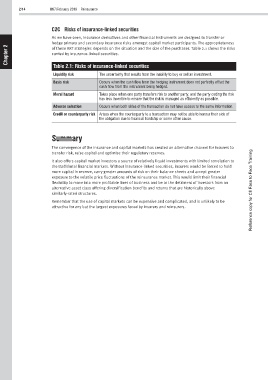Page 54 - M97TB9_2018-19_[low-res]_F2F_Neat2
P. 54
2/14 M97/February 2018 Reinsurance
C2C Risks of insurance-linked securities
As we have seen, insurance derivatives and other financial instruments are designed to transfer or
hedge primary and secondary insurance risks amongst capital market participants. The appropriateness
2 of these ART strategies depends on the situation and the size of the purchaser. Table 2.1 shows the risks
Chapter carried by insurance-linked securities.
Table 2.1: Risks of insurance-linked securities
Liquidity risk The uncertainty that results from the inability to buy or sell an investment.
Basis risk Occurs when the cash flow from the hedging instrument does not perfectly offset the
cash flow from the instrument being hedged.
Moral hazard Takes place when one party transfers risk to another party, and the party ceding the risk
has less incentive to ensure that the risk is managed as efficiently as possible.
Adverse selection Occurs when both sides of the transaction do not have access to the same information.
Credit or counterparty risk Arises when the counterparty to a transaction may not be able to honour their side of
the obligation due to financial hardship or some other cause.
Summary
The convergence of the insurance and capital markets has created an alternative channel for insurers to
transfer risk, raise capital and optimise their regulatory reserves.
It also offers capital market investors a source of relatively liquid investments with limited correlation to
the traditional financial markets. Without insurance-linked securities, insurers would be forced to hold
more capital in reserve, carry greater amounts of risk on their balance sheets and accept greater
exposure to the volatile price fluctuations of the reinsurance market. This would limit their financial
flexibility to move into more profitable lines of business and be to the detriment of investors from an
alternative asset class offering diversification benefits and returns that are historically above Reference copy for CII Face to Face Training
similarly-rated structures.
Remember that the use of capital markets can be expensive and complicated, and is unlikely to be
attractive for any but the largest exposures faced by insurers and reinsurers.

